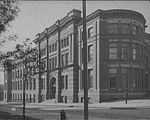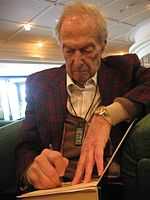Wistar Institute
| The Wistar Institute | |
|---|---|
|
| |
| Established | 1892 |
| President and CEO | Dario C. Altieri, M.D.[1] |
| Faculty | 109[1] |
| Staff | 325[1] |
| Budget | $48,578,000 (2008)[1] |
| Location | University City, Philadelphia, Pennsylvania |
| Address | 3601 Spruce Street, Philadelphia, PA 19104 |
| Website | The Wistar Institute |
The Wistar Institute is a biomedical center, with a focus on cancer research and vaccine development. It is located in the University City section of Philadelphia, Pa. Founded in 1892 as the first independent, nonprofit, biomedical research institute in the country, Wistar has held the Cancer Center designation from the National Cancer Institute since 1972. Wistar has more than thirty laboratories, which are home to three research programs: a gene expression and regulation program, a molecular and cellular oncogenesis program, and a tumor microenvironment and metastasis program.
Research
Cancer
The Institute's research program on cancer includes the following goals and areas:
- Stem cells: identifying and characterizing cancer stem cells that appear to be responsible for recurrent and treatment-resistant forms of cancer.
- A blood test for the early detection of lung cancer: By the time lung cancer, the top cancer killer, is diagnosed, the disease has usually advanced so far that treatment options are limited. Wistar's scientists are developing a blood test that would detect the disease early.
- Telomerase-based cancer treatment: The decoding by a Wistar researcher of a key structure of the enzyme telomerase, which plays a significant role in cancer, may lead to the development of a new class of highly targeted cancer drugs.[2]
- Melanoma: Wistar's melanoma research program studies the development of the disease and pursuing treatments for advanced melanoma.
Immunology
- Past achievements: Wistar discoveries led to the creation of the rubella vaccine that is credited with eradicating “German measles” in the United States;[3] human rabies vaccines used worldwide; and a rotavirus vaccine approved in 2006 that prevents an illness responsible for the deaths of hundreds of thousands of children worldwide each year.
- Vaccine development: Wistar researchers are collaborating with leading scientists worldwide to develop vaccines for hepatitis C, malaria, and other potentially deadly diseases. Wistar is also working on a universal influenza vaccine that would be effective against all strains of influenza, including avian flu.
- Vaccine licensing: The Institute has licensed its rabies and rubella vaccine seed stock to companies in China, India, and Russia to help these countries develop affordable vaccines for their own populations.
- Autoimmune disease: Wistar immunologists are developing new therapies for autoimmune diseases such as lupus and rheumatoid arthritis.
- HIV-1 Infection: Wistar scientists are developing new strategies for immunotherapy and collaborating with scientists locally and worldwide to develop a greater understanding of cases of natural resistance against infection (exposed uninfected) or disease progression (infected that control virus without therapy).
Training and outreach
Wistar's training and outreach initiatives include:
- Educating area youth: Wistar offers internships, tours, and contests to area high school students to stimulate and nurture their interests in science. The Institute also offers a two-year training program for biomedical technicians in partnership with the Community College of Philadelphia.
- Engaging the community: The Institute hosts community events including lectures by noted science authors that are designed to stimulate science learning and discussion.
- Training the scientists of tomorrow: Over the past decade, nearly a thousand researchers, from predoctoral students to postdoctoral fellows and visiting scientists, have trained at Wistar.
History

The Wistar Institute was founded in 1892 as the nation’s first independent medical research facility.
It is named for Caspar Wistar, a prominent Philadelphia physician. Born in 1761, Wistar began his medical practice in 1787 and later wrote the first American anatomy textbook. To augment his medical lectures and illustrate comparative anatomy, Wistar began collecting dried, wax-injected, and preserved human specimens. Two years before his death in 1818, he gave the collection to William Edmonds Horner, another physician. Horner expanded the collection, which became known as the Wistar and Horner Museum, and was further expanded by its next curator, Joseph Leidy, M.D., who added animal specimens and fossil and anthropological samples. By the late 1880s, the collection was beginning to show signs of neglect and wear, compounded by a fire in Logan Hall at the University of Pennsylvania, where the museum was housed.

Wistar’s great-nephew Colonel Isaac Jones Wistar became involved in a fundraising campaign to refurbish and re-house the collection. Determined to preserve his great-uncle’s teaching collection and support new and original research of anatomy and biology, Isaac Jones Wistar funded an endowment and research building for The Wistar Institute of Anatomy and Biology. Designed by Philadelphia architects George W. and William G. Hewitt, the original building is still part of the Wistar Institute’s research facility, and is listed in the National Register of Historic Places as part of the historic University City area in Philadelphia.
Today, part of the human and animal skeletal collection is housed at the University of Pennsylvania Museum of Archaeology and Anthropology.

In 1906, under Milton Greenman, M.D., and Henry Donaldson, Ph.D., the Institute developed and bred the Wistar rat, the first standardized laboratory animal. It is estimated that more than half of all laboratory rats today are descendants of the original Wistar rat line.[4][5]
Notable members
- Peter C. Doherty, Ph.D.: Doherty, an Australian veterinary surgeon and researcher in the field of medicine, has worked with the Institute since 1975, and is currently an emeritus member of the Institute's Board of Trustees. Doherty has received the Albert Lasker Award for Basic Medical Research (1995), the Nobel Prize in Physiology or Medicine jointly with Rolf M. Zinkernagel (1996), and was named Australian of the Year (1997).
- Leonard Hayflick, Ph.D.: Hayflick is known for discovering that human cells divide for a limited number of times in vitro. This is known as the Hayflick limit.
- Hilary Koprowski, M.D.: Koprowski, a Polish virologist and immunologist, is the inventor of the world's first effective live polio vaccine. He served as director of the Institute from 1957 to 1991, a period during which Wistar achieved international recognition for its vaccine research and became a National Cancer Institute Cancer Center. He holds the title of Professor Laureate at Wistar and also serves on its Board of Trustees. Koprowski's numerous awards and distinctions include a Fulbright Scholarship, the Alvarenga Prize of the College of Physicians of Philadelphia (1959), Belgium's Royal Order of the Lion, the French Order of Merit for Research and Invention, the San Marino Award for Medicine (1989), the Nicolaus Copernicus Medal of the Polish Academy of Sciences, the Philadelphia Cancer Research Award, the John Scott Award, the Philadelphia Award (May 1990), the title of "Commander of the Order of the Lion of Finland" (1995), the Legion d'Honneur (1997), the Grand Cross of the Order of Merit of the Republic of Poland (1998), and the Albert B. Sabin Gold Medal (2007).
 Koprowski, Warsaw, 2007
Koprowski, Warsaw, 2007
- Ruth Patrick, Ph.D.: Patrick is an American botanist and limnologist specializing in diatoms and freshwater ecology, who developed ways to measure the health of freshwater ecosystems and established a number of research facilities. Her work has been widely published and she has received numerous awards for her scientific achievements, including the National Medal of Science in 1996 and the Heinz Award Chairman's Medal in 2002. Patrick is currently an emeritus member of the Institute's Board of Trustees.
- Stanley Plotkin, M.D.: Plotkin is an American physician, who, in the 1960s, played a pivotal role in discovery of a vaccine against the rubella virus while working at Wistar. Plotkin was a member of Wistar’s active research faculty from 1960 to 1991. Plotkin’s professional awards include the Institute of Medicine of the National Academies(2005); the Albert B. Sabin Gold Medal (2002); the French Legion Medal of Honor (1998); the Clinical Virology Award, Pan American Group for Rapid Viral Diagnosis (1995); the Distinguished Physician Award, Pediatric Infectious Disease Society (1993); and the Bruce Medal of the American College of Physicians (1987).
- Tadeusz J. Wiktor, DVM: a veterinarian and part of the team which developed the human diploid cell vaccine for use protecting humans against rabies. Former head of the Institute's rabies unit.
Current Members
- Dario Altieri
- Andrew Caton
- Jose Conejo-Garcia
- Jan Erikson
- Hildegund C.J. Ertl
- Dmitry Gabrilovich
- Scott Hensley
- Meenhard Herlyn
- Chih-Chi Andrew Hu
- Qihong Huang
- Susan Janicki
- Russel Kaufman
- Paul Lieberman
- Qin Liu
- Luis Montaner
- Maureen Murphy (scientist)
- Yulia Nefedova
- Kazuko Nishikura
- Ken-ichi Noma
- Frank Rauscher III
- Harold Reithman
- Louise Showe
- Emmanuel Skordalakes
- David Speicher
- Jessie Villanueva
- Ashani Weeraratna
- Rugang Zhang
See also
References
- ↑ 1.0 1.1 1.2 1.3 "Official website of the Wistar Institute". The Wistar Institute. Retrieved 3 July 2009.
- ↑ "Hopes raised for block on cancer". BBC News (BBC). 31 August 2008. Retrieved 25 April 2010.
- ↑ "Rubella vaccines for the former USSR". Chemistry World News. The Royal Society of Chemistry. 17 January 2006. Retrieved 25 April 2010.
- ↑
- ↑ "The Wistar Institute:History". The Wistar Institute. 2007. Retrieved 2008-11-09.
External links
Coordinates: 39°57′03″N 75°11′44″W / 39.95093°N 75.19549°W